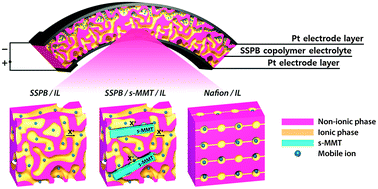High-strain air-working soft transducers produced from nanostructured block copolymerionomer/silicate/ionic liquid nanocomposite membranes†
Abstract
The present work demonstrates that nanostructured middle-block sulfonated styrenic pentablock

* Corresponding authors
a
Center for Materials Architecturing, Institute for Multi-Disciplinary Convergence of Materials, Korea Institute of Science and Technology (KIST), Seoul 136-791, Republic of Korea
E-mail:
koo@kist.re.kr
Fax: +82 2 958 5309
Tel: +82 2 958 6872
b Nanomaterials Science and Engineering, University of Science and Technology, Daejeon 305-350, Republic of Korea
The present work demonstrates that nanostructured middle-block sulfonated styrenic pentablock

 Please wait while we load your content...
Something went wrong. Try again?
Please wait while we load your content...
Something went wrong. Try again?
J. Lee, S. Yu, S. M. Hong and C. M. Koo, J. Mater. Chem. C, 2013, 1, 3784 DOI: 10.1039/C3TC30414K
To request permission to reproduce material from this article, please go to the Copyright Clearance Center request page.
If you are an author contributing to an RSC publication, you do not need to request permission provided correct acknowledgement is given.
If you are the author of this article, you do not need to request permission to reproduce figures and diagrams provided correct acknowledgement is given. If you want to reproduce the whole article in a third-party publication (excluding your thesis/dissertation for which permission is not required) please go to the Copyright Clearance Center request page.
Read more about how to correctly acknowledge RSC content.
 Fetching data from CrossRef.
Fetching data from CrossRef.
This may take some time to load.
Loading related content
